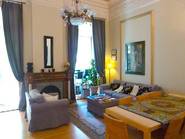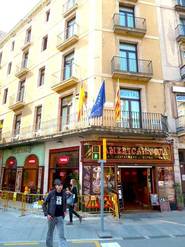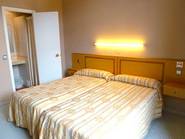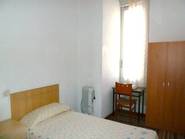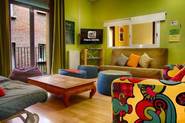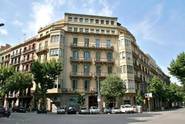Location, location, location. Choosing the right neighborhood is key. Here’s a list of considerations when choosing the neighborhood for your hotel.
Choosing a Neighborhood in Barcelona

Looking up the Rambla from the port.
Barcelona Neighborhoods
Though Barcelona spreads over many ‘hoods or "barris," some are better for seeing the city sights than others. Generally, staying in the old city will put you nearer to big guidebook attractions and nightlife, while staying in the Eixample offers a less touristy experience.
Here are the basics on Barcelona "barris."
1.Gothic Quarter
Like charm? This is where to find it in Barcelona. On the right side of La Rambla (if looking up La Rambla from the Sea) is the city’s Gothic Quarter, brimming with cobblestones, funky boutiques, seedy bars, night clubs, museums, a Cathedral, and many fine restaurants. It’s central. It’s also touristy and easy to get lost in.
We recommend staying off La Rambla for less noise and lower rates. Our top Gothic picks? Itaca Hostel is the spot for budget backpacker travelers while Hostal Fernando offers a little something for everyone.
More hotel picks in the Gothic Quarter.
2. El Raval
Crossing over La Rambla from the Gothic Quarter you’ll come to El Raval, Barcelona’s mixed bag. Yes, it offers eccentric nightlife options, cafes where "artsy" folks scribble in notebooks, and some top-notch restaurants, but it also has a bad reputation for being popular with pickpockets. A pro is it’s very central, being one of the "barris" hugging Plaça Catalunya. It’s vibe is young, alternative, and hipster but also ethnic. Many immigrants live in this area, and some of the city’s best kebab stands are here.
The best bet? Stay on the outer fringe of El Raval in Hosteria Grau near the CCCB Museum and music shops on Tallers street.
See all recommended hotels in El Raval.
3. Eixample, Left & Right
The Eixample is divided by the swanky shopping street Passeig de Gràcia where well-dressed ladies and gents sashay with Prada and Chanel bags swinging from bejeweled hands. From the sea looking up Passeig de Gràcia: On your left you have the Left Eixample, also known as Gay Eixample, and on your right the Right Eixample where La Sagrada Familia is located.
Both Eixamples are crowded with upscale boutiques, exclusive restaurants, and architecture that makes the head spin. This is where the highest concentration of Gaudí buildings are in Barcelona. Generally, the Right Eixample is more residential, safe, and quiet while the Left offers a bit more in the way of nightlife. Both are less touristy and safer than the Gothic and Raval.
Where would we stay in the Eixamples? We love the Left’s Astoria Hotel near Diagonal and the Right’s Fashion House B&B.
See all hotels in the Eixample.
4. Gràcia
"Cool" is Gràcia’s middle name. This "barri," located just above the Eixamples, used to be a compact country village before Barcelona took it over; hence the main drag’s name, Passeig de Gràcia. Theater, indie film, bohemian bars, brunch, and creative shops abound in this area.
Guess what? Not many tourists. Locals love to live here. One of Gaudí’s first buildings, Casa Vincens, is found here.
5. Poble Sec
This neighborhood is making a comeback. Once the theater and entertainment capital of the city (think pre-television), Poble Sec was all but forgotten until recently. Now locals line up for live music at El Apolo Club concert hall, seek musicals and cabaret shows along Para-lel, and linger over drinks in the ‘hood’s many original bars and eateries.
Following this trend, new hotels and hostals have opened up in Poble Sec. We recommend HelloBCN for a top-notch youth hostel as well as Hostel One Paralelo for backpacker digs with a hot tub!
See more hotels in Poble Sec.
6. La Barceloneta
Once a fisherman's neighborhood, La Barceloneta is the city’s seaside ‘hood. It’s famous for ridiculously small flats (think 30 m2), superb seafood, and an unrefined allure. This area is an excellent choice if looking to spend time on the beach and is also within walking distance to the Gothic Quarter and La Ribera.
7. La Ribera or El Born
All the appeal of the Gothic Quarter but with fewer tourists. It’s here you’ll come across the Picasso Museum, the Santa Maria del Mar church, Ciutadella Park, oodles of bars, avant-guard boutiques, and restaurants for every palate and pocketbook. While not as central as El Raval or the Gothic, La Ribera is close to the sea and within walking distance to many old city sights.
What’s more, within La Ribera’s perimeter some of our favorite hotels are found. Hotel Banys Orientals is a stellar value and Park Hotel is a vintage pleaser.
More recommended hotels in La Ribera.
8. Poblenou
Most of the action happens around this ‘hood’s Rambla. A favorite with residents, Poblenou is close to the sea, but not close to much else. Stay near the Poblenou metro stop, and avoid the Llacuna and Bogatell metro stops which are mostly deserted. The cutting-edge @22 technology-centered, business zone and ultramodern apartment buildings associated with it are all located here. A fine place to stay to feel Barcelona’s local pulse way out of touristville.
9. Other neighborhoods
Horta? El Clot? La Pau? Hospitalet? These areas do offer accommodations, but you’ll be way out of downtown and will be forced to take public transportation everywhere, which can severely limit how late you stay out and what you see.
Our EuroCheapo tip is to stay central and avoid these outer ‘bargain barris’.
Related articles
• Accommodation in Barcelona: What to expect from the city's hotels, hostals, hostels, pensions and more.
• All Barcelona hotels inspected and reviewed by EuroCheapo.
• When to go: the best seasons to visit Barcelona.
• Our favorite youth hostels in Barcelona.
About the author: Regina W. Bryan is EuroCheapo's Barcelona-based correspondent. Read her reviews of hotels in Barcelona and her regular posts in EuroCheapo's Barcelona blog.

